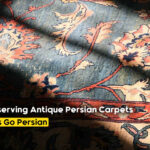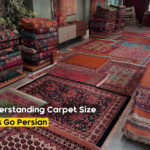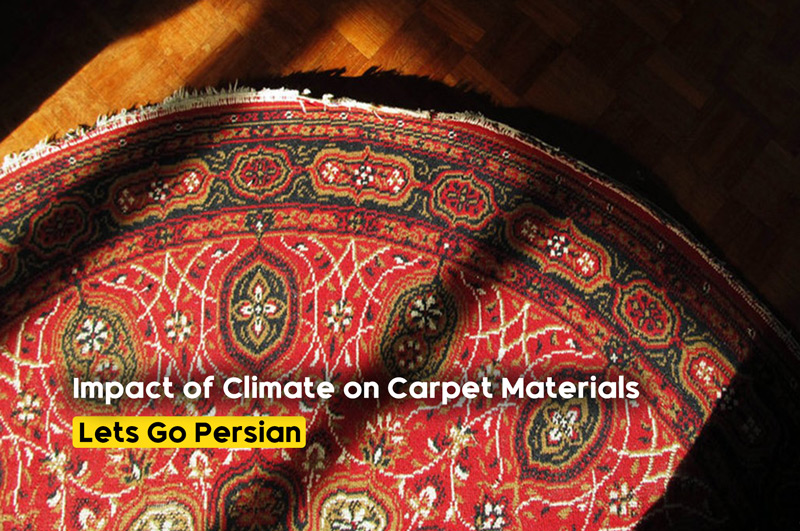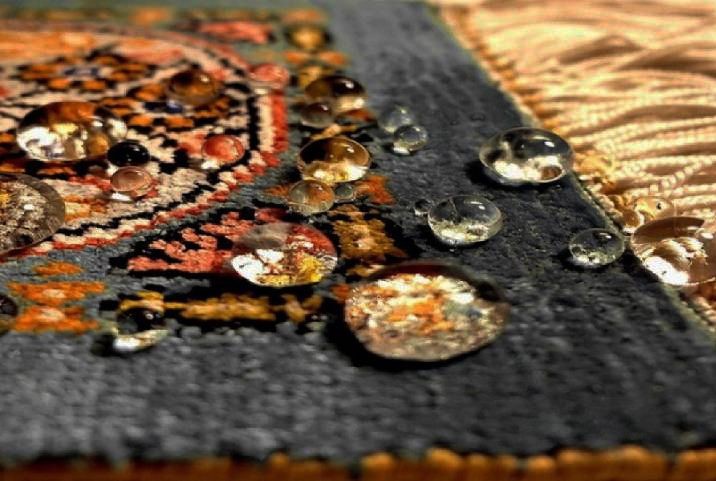
Preserving Antique Persian Carpets

Carpet Sizes: Finding the Perfect Size for Your Space
The longevity and durability of carpets, especially hand-woven Persian carpets, are influenced not only by their craftsmanship but also by the climate in which they are kept. Temperature, humidity, and exposure to natural elements can significantly affect the fibers, dyes, and structure of carpets over time. Whether you’re living in a hot, dry climate or a cold, damp one, understanding how the environment impacts your carpet is crucial for ensuring its long-term preservation. In this post, we will explore how different climates affect carpet materials, and provide tips on how to protect and care for your carpets in various conditions.

The Impact of Climate on Carpet Materials and Longevity
1. Humidity and Moisture: The Silent Threat to Carpet Fibers
The Effects of High Humidity
High humidity levels can have a damaging effect on carpets, particularly those made from natural fibers such as wool, silk, or cotton, which are common in Persian carpets. When carpets are exposed to excess moisture, it can lead to several issues that compromise their durability and appearance.
- Mold and Mildew: In humid environments, carpets are at greater risk of developing mold and mildew. These fungi thrive in damp conditions and can break down the fibers, leading to rot and permanent damage. Mold and mildew not only ruin the structure of the carpet but also create unpleasant odors.
- Stretching and Warping: Excess moisture can cause the fibers in the carpet to expand, leading to stretching and warping. This results in unsightly wrinkles or waves in the carpet, which may become permanent if not addressed.
- Fiber Weakening: Wool and cotton fibers are particularly susceptible to moisture, which can weaken their structure over time. Repeated exposure to humidity can cause the fibers to break down, leading to a loss of durability and strength.
The Effects of Low Humidity
On the other hand, low humidity or overly dry conditions can also pose challenges for carpets, particularly those made from natural fibers like wool and silk.
- Fiber Drying and Cracking: When exposed to extremely dry environments, carpet fibers can become brittle and more prone to cracking. Wool, for example, needs some moisture to retain its elasticity, and too little humidity can make the fibers stiff and prone to breakage.
- Color Fading: Low-humidity environments, often coupled with excessive sunlight, can cause the colors of the carpet to fade more quickly. The dyes in natural fibers are particularly vulnerable to this type of climate, losing their vibrancy over time.
Prevention Tips for Humid and Dry Climates
- Control Humidity Levels: In humid climates, use a dehumidifier to maintain indoor humidity levels between 40% and 60%, which is ideal for preserving natural fibers. In dry climates, consider using a humidifier to add moisture to the air and prevent fibers from drying out.
- Ventilation: Ensure that your space is well-ventilated to reduce the buildup of moisture. In humid environments, good airflow can help prevent mold and mildew from forming.
- Avoid Storing Carpets in Damp Areas: Avoid placing or storing carpets in basements, attics, or other areas prone to high humidity or dampness. If storing a carpet in a humid environment is unavoidable, make sure to use moisture-absorbing materials like silica gel in the storage space.

The Impact of Climate on Carpet Materials and Longevity
2. Temperature Extremes: Hot vs. Cold Climates
Hot Climates and Carpet Longevity
In hot climates, the combination of high temperatures and low humidity can accelerate the degradation of carpet fibers, particularly natural ones like wool and silk.
- Fiber Dehydration: High temperatures, especially when combined with low humidity, can cause carpet fibers to lose moisture, leading to brittleness and cracking. Wool and silk fibers, which require a balance of moisture to remain supple, are particularly vulnerable.
- Color Fading from Heat: Prolonged exposure to high temperatures, especially when coupled with direct sunlight, can cause fading of the carpet’s colors. Natural dyes, often used in Persian carpets, can degrade faster under hot conditions.
- Insect Infestations: In hot, dry climates, moths and carpet beetles may seek out carpets made from wool, silk, and cotton, causing significant damage if not detected early.
Cold Climates and Carpet Durability
In cold climates, particularly in areas where central heating is used extensively during the winter, carpets can suffer from dry air due to indoor heating systems, while colder outdoor temperatures can affect moisture levels.
- Shrinkage and Stiffening: Natural fibers like wool can become stiff in very cold conditions, leading to shrinkage and reduced flexibility. Sudden changes from cold to hot temperatures (e.g., when a home is heated quickly) can also cause the carpet fibers to contract and expand, potentially leading to distortion or wrinkles.
- Condensation and Moisture Buildup: In homes where the windows and walls are not well insulated, condensation can form, leading to dampness and increased risk of mildew on carpets, particularly near walls and windows.
- Static Electricity: In cold, dry environments, static electricity can become an issue with wool carpets, causing dust and dirt to cling to the fibers and making the carpet harder to clean.
Prevention Tips for Hot and Cold Climates
- Limit Sun Exposure: In hot climates, use curtains or blinds to shield carpets from direct sunlight. Alternatively, you can place carpets in areas that receive less intense sunlight during the day.
- Proper Insulation: Ensure your home is well-insulated to prevent drastic temperature fluctuations, particularly in cold climates. Insulated windows and walls help avoid condensation and moisture issues.
- Humidity Control: During winter months in cold climates, use a humidifier to maintain appropriate humidity levels indoors and prevent carpets from drying out due to central heating.
- Regular Cleaning: In hot climates, regularly check for insect infestations, particularly moths and beetles. Vacuum and clean the carpet thoroughly to prevent insect damage.
3. The Impact of Direct Sunlight
UV Rays and Color Fading
Direct sunlight is one of the most damaging environmental factors for carpets, particularly those made with natural dyes. UV rays can cause colors to fade unevenly, leaving carpets looking dull or discolored.
- Fading of Natural Dyes: Persian carpets, which often use natural dyes derived from plants, minerals, and insects, are especially susceptible to fading when exposed to UV rays. The reds, blues, and greens in these carpets can become noticeably lighter after prolonged exposure.
- Brittleness from UV Exposure: In addition to fading, the fibers of the carpet, especially wool and silk, can become brittle and weakened when exposed to sunlight over long periods.
Prevention Tips for Sunlight Exposure
- Use Window Films: Install UV-blocking window films on windows that receive direct sunlight. These films reduce the amount of harmful UV rays entering the room while allowing natural light to filter through.
- Rearrange Furniture: Consider rearranging your furniture periodically to change the areas of the carpet that are exposed to sunlight. This helps prevent uneven fading.
- Rotate the Carpet: If moving the furniture isn’t an option, rotate the carpet every few months to ensure that no one part of the carpet is continuously exposed to direct sunlight.
4. Handling Carpet Materials in Coastal or Tropical Climates
Coastal Climates: Salt and Humidity
Coastal climates are characterized by high humidity and the presence of salt in the air, both of which can impact the longevity of carpets, particularly those made from natural fibers.
- Salt Damage: Salt in the air can accumulate in the fibers of the carpet, leading to stiffness and weakening of the fibers over time. Salt can also attract moisture, increasing the risk of mold and mildew.
- Moisture and Humidity: The high humidity levels typical of coastal regions can cause carpets to retain moisture, which can lead to mold, mildew, and fiber decay.
Tropical Climates: High Heat and Humidity
In tropical climates, the combination of high heat and humidity creates an environment where carpets are at increased risk for mold, mildew, and pest infestations.
- Mold and Mildew Growth: The constant warmth and moisture in tropical environments create the perfect breeding ground for mold and mildew, which can quickly deteriorate carpet fibers.
- Insect Infestations: The high humidity and warmth also encourage the growth of carpet beetles and moths, which can eat away at natural fibers like wool and silk.
Prevention Tips for Coastal and Tropical Climates
- Air Circulation: Ensure proper air circulation in rooms where carpets are placed. Use dehumidifiers to control humidity levels and prevent moisture buildup.
- Frequent Cleaning: Regularly vacuum and clean carpets to remove any salt residue or moisture that could lead to fiber damage.
- Insect Prevention: Use moth repellents or cedar blocks to protect carpets from insect infestations in tropical climates.
Conclusion
The climate in which a carpet is kept can have a profound impact on its materials, appearance, and longevity. Whether you’re dealing with the high humidity of coastal or tropical regions, the extreme heat of desert climates, or the cold dryness of winter, it’s important to take proactive measures to protect your carpets. By controlling humidity, limiting sun exposure, and addressing specific challenges related to temperature and moisture, you can help preserve the beauty and durability of your Persian carpets for years to come.



















